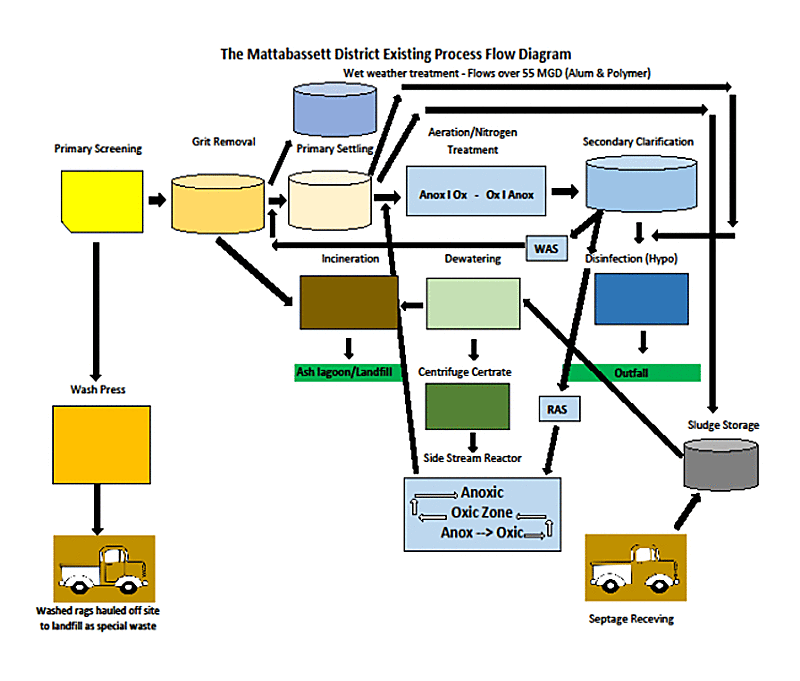How It Works
The Treatment Process
The Mattabassett District Water Pollution Control Facility is designed to treat 35 million gallons a day (MGD), with a peak flow of 110 MGD. The plant also accepts and treats septage and grease from septic tank cleaning trucks and liquid biosolids from other wastewater treatment plants.The Mattabassett District employs a 4-Stage Bardenpho process to remove dissolved solids, organic material, and nutrients in wastewater. This process regularly removes at least 98% of these pollutants. Between May 1st and October 15th the District disinfects the effluent with Sodium Hypochlorite before discharging to the Connecticut River.
Liquid Treatment
The District maintains a 9 mile concrete trunkline sewer which ranges in size from 60” to 72” diameter. This trunkline conveys wastewater from New Britain, Berlin, Cromwell, and parts of Middletown. The wastewater then flows through two ½” bar screens to remove large debris which could potentially cause clogging issues downstream. The bar screens then direct this debris to a wash press before being hauled to a landfill for disposal. The wastewater is then pumped to two grit removal tanks, which slow the flow of wastewater to 1 foot per second, causing heavy inorganic particles and grit (sand, egg shells, coffee grounds, etc.) to sink to the bottom. The grit is then pumped to grit classifiers which clean and dry it before incineration.Two Parshall Flumes measure the wastewater volume. A distribution channel aerates the wastewater to prevent deposition of solids before splitting the flow to our 4 primary clarifiers. These tanks are 1 million gallons each, and it takes roughly 2.5 hours for wastewater to flow through. These clarifiers settle out and remove solids, while also skimming floating solids such as fats, oils, and grease. These solids are then pumped to storage tanks before being dewatered and incinerated.
Our 6 aeration tanks begin the secondary treatment and nitrification/denitrification process, where bacteria present in the wastewater remove the dissolved organic matter, nutrients, and ammonia, which is toxic to aquatic life. The 4-Stage Bardenpho process creates separate zones that differ in dissolved oxygen levels that “grow” different species of bacteria that are desirable. This bacteria convert’s toxic ammonia to harmless nitrogen gas. From the aeration tanks, the liquid biomass flows into 6 secondary clarifiers, where movement is slowed to remove and recycle the biomass back to the aeration tanks. Clear liquid from the Secondary Clarifiers then flows into a Mixing Chamber where sodium hypochlorite kills disease-causing bacteria. The District routinely provides treatment at the 98% to 99% levels of all monitored parameters. This is significantly higher than the minimum requirement of 85%. The disinfected effluent flows through the outfall line - two hundred sixty feet from shore - into the 160-foot long diffuser pipe twenty feet below the surface of the Connecticut River. At an average daily flow of 20 MGD, this whole process takes approximately 6-8 hours.
Biosolids Treatment
From the Biosolids Storage Tanks, biosolids are pumped to 3 centrifuges. These centrifuges spin the liquid biosolids to dewater the solids to 25%, which is called “cake”. The cake is then pumped to our fluidized bed incinerator, where the biosolids are completely combusted in 19 tons of "boiling" sand heated to 1400° Fahrenheit.The gas temperature increases to 1550° Fahrenheit, further ensuring complete destruction of organic material. In addition to providing odor free emissions, the incinerator emissions are processed through a state-of-the-art wet electrostatic precipitator (WESP) and gas/air conditioner before passing through a granulated activated carbon (GAC) bed. This system ensures The District's emissions are below the new stringent EPA Quad-L emission limits. The Mattabassett District is the first incinerator in the United States to meet these new regulations. The sterile ash is disposed of at the District's ash disposal landfill located in Berlin.
Odor Control
Odor control and treatment systems were first installed in 1991. With the Nitrogen Upgrade Construction Project that was completed in 2015, all the odor control systems were replaced. Many of the process tanks and areas that generate odors are covered. Since the full implementation of the odor control systems, some of which are state-of-the-art systems, the District now receives very few odor complaints.The odor control system consists of two wet chemical scrubbers, a bioway purspring tower, and 6 coconut shell-based granular activated carbon towers. These systems can scrub the hydrogen sulfide gas and malodorous air that is produced by raw sewage, dewatering operations, and merchant sludge deliveries.
In addition to these physical odor control systems, The District also utilizes odor control masking agents when necessary.
Upon completion of the Nitrogen Upgrade Project in 2015, The Mattabassett District has spent over $6.3 million on odor control systems, and we are constantly evaluating and refining our methods and our equipment. In addition to this, we spend over $100,000 annually on maintenance and carbon media replacement. Our underlying stated goal has always been to be a good neighbor. To this end, we are committed to making certain that our facilities are odor free.
In 2024, the District completed a plant wide odor monitoring and existing odor treatment systems evaluation to determine if there are any fugitive nuisance odors in the plant. The evaluation has determined that there are fugitive odors that escape several treatment systems, or that our existing odor treatment systems have additional capacity to treat odors. The District has selected several odor control capital improvement projects that are planned for the 2025-2026 fiscal year.
Here are the 2025-2026 fiscal year odor control projects and estimated project schedule:
Odor control evaluation and improvement projects:
- Work with City of Middletown to improve Bioxide dosing in the forcemain as well as providing dosing(odor treatment) in the winter months -Evaluation spring 2025, Dosage increase summer 2025
- Evaluate new odor control unit at the inlet of the Middletown pump station (forcemain) connection - Evaluate design and contract bidding fall 2025, construction fall 2025
- Improvements & repairs to the sludge storage bioway sump- Design and contract bidding spring 2025, construction summer 2025
- Improvements to the odor control unit for the centrate pump station- Design and contract bidding June 2025, construction completion fall 2025
- Install a roll-up door at the north side of the Dewatering Building - Design and contract bidding Spring 2025, construction summer 2025
- Air flow improvements to various existing odor control units- Summer 2025


